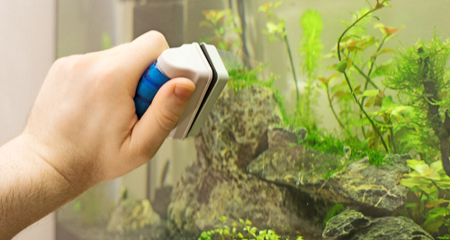
Do you ever wonder what causes algae to grow and take over your pond? Why is it so hard to control? Why is this plant so hard to get rid of? Huge algae blooms are caused by increased nutrient loading in our water ways from population growth, worldwide travel, climate change and pollution from toxins. Nitrogen and phosphorus and seeping into our water from fertilizers and other environmental toxins and feeding the rapid overgrowth of algae. Nutrient sources, like fertilizers, grass clippings, leaves, animal waste, nutrient rich rain and eroded sediment can cause an explosion of algae growth.
Long term actions you can take to reduce nutrient overload in your pond.
Choose natural management methods like pond aeration and sub-surface aeration oxygen bubbles to help oxygenate the water and reduce the availability of excess nutrients.
Testing the water to determine the levels of excess nutrients is the first step.
Adding Oxygen
Oxygen is needed for life, and that includes the micro life under the surface of your pond. But if pollution, invasive aquatic plants and toxic algae blooms cover the surface of the water, this will prevent oxygen from getting to the areas that need it. What will happen then is poor water quality, foul odors, bottom muck build up, possible fish kills and scary toxic algae blooms.
Luckily, several lake and pond aeration solutions are available to naturally correct imbalanced conditions—each having a unique benefit, but also some limitations:
Many pond owners like the Floating architectural fountains for aeration and aesthetics in lakes and ponds. Correctly sized fountains will provide water column mixing in shallow waterbodies not deeper than 6’. As the spray from the fountain falls from the air in their beautiful spray, it spreads across the surface, forcing the release of submersed gases, helping to stop nutrient pollution, and introducing beneficial oxygen onto the surface of water.
Another form of decorative aeration in large lakes and ponds is a floating surface or decorative aerator. This option allows you to have the beautiful spray but will aerate at a much higher volume.
A new aeration option is submersed micro bubble aerators.
Submersed aeration
In contrast to fountains, submersed aeration systems utilize an air pump placed on the shore, that pumps air through subsurface weighted tubes and diffusers that oxygenate the water from bottom to top. As the bubbles rise to the surface, they increase oxygen throughout the waterbody and disrupt stratification. Similar to floating fountains or aerators, submersed aeration systems help change nutrients to more diluted forms that cannot sustain nuisance aquatic weed and algae growth, These systems are placed at the bottom of the pond as they may not properly circulate shallow water.
This aeration alternative has helped maximize the benefits of both decorative floating fountains and surface aeration systems.
These micro oxygen bubbles are much more effective at illuminating bad odors, breaking down bottom muck and bringing back water quality.
Shade from the sun
Plants like algae need the sun to grow. That is why using pond dye is a great tool for blocking the sun. Applying organic blue dye in your pond acts like a shade or umbrella that blocks the suns uv rays, therefore stunting the growth of algae. In addition to that, the color of the dye adds such a beautiful tropical look to the pond and at the same time it will protect the sensitive eco system that lives beneath. Pond dye is non toxic, so safe for people, fish and other wildlife and organisms living in the water. It is also very inexpensive, usually one dose will treat up to a surface acre and can last up to eight weeks. The most common pond dye is a deep tropical blue, but also available are unique colors like aquamarine which is a light bluish green color. Also available is black dye. Now most people would shy away from that color, but it is rather unique. It takes on a look of a mirror and can be quite mystic. Choose your color by keeping in mind the landscape that your pond is surrounded by. Deep blue, aquamarine or black!
Algae eating Carp
Grass Carp are hungry algae and aquatic plant eating fish. These fish are a great addition to your ponds maintenance plan and can be fun entertainment as well, watching the fish come to the shore where the aquatic weeds are growing. The problem with Grass Carp is that they reproduce rapidly, so it is imperative that you purchase sterile Grass Carp so that you can control this population.
Each of these solutions work differently—and they accomplish very different things. Using them as a combined solution, depending on your ponds condition, will help target your water quality problems. Pond dye, beneficial bacteria and enzymes and sufficient aeration, when introduced ahead of the algae season, will reduce the growth, and allow you pond thrive as a balanced aquatic environment. All of these approaches are fairly inexpensive, eco friendly and easy to implement.